Otter Unknown Kappa
Posted by: Loren Coleman on March 7th, 2008
Brent Swancer, from Japan, is my guest contributor for today. He introduces us to a known animal with a foggy cryptic presence today and its links to an extremely well-known Japanese cryptid:
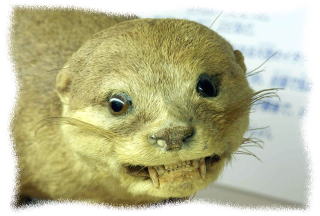
The Japanese River Otter (Lutra nippon) is a nocturnal predator, endemic to Japan, which reaches 26 to 30 inches long at maturity. Inhabiting mostly midstream and downstream regions, it was once found abundantly throughout Japan.
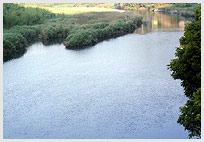

The numbers of Lutra nippon decreased rapidly beginning around the Maiji and Taisho eras due to hunting for its fur and liver (which was used as a medication for tuberculosis) and further continued with habitat destruction, water contamination, large scale river construction, and even attacks by domestic dogs. Although they were designated as a Special Natural Treasure in 1965, the steady rate of decline continued.
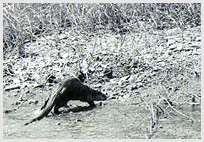
The last known official sighting of a Japanese River Otter was in 1979 in Kochi prefecture, although uncorroborated sightings continue to this day. It is currently listed as critically endangered and thought to only be present in the Southern area of Shikoku island, a fraction of its former range.
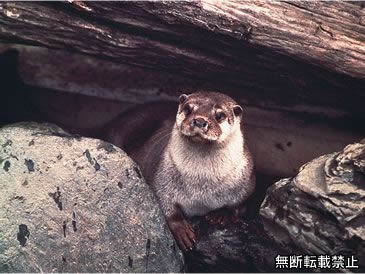
Official searches have been commissioned by both prefectural governments and non- governmental organizations in recent years in order to find any remaining specimens and hopefully salvage the species if it is still out there. So far they have been unsuccessful in finding any, which unfortunately means it may be too late.
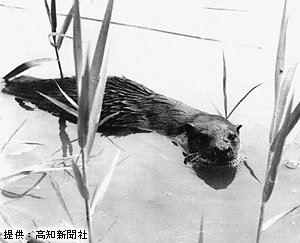
Interestingly, the Japanese River Otter is thought by some in cryptozoological circles here in Japan to be an explanation behind the sightings of another (an – otter?) Japanese cryptid, the legendary Kappa.
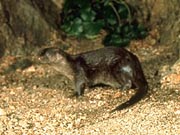
Funny how it always comes down to otters, even when the otter itself is more or less a cryptid.
Otterly perplexing.
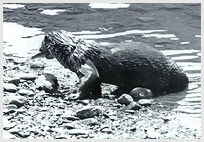
+++++++++++
Much appreciation to Brent for his guest blog. Below is a quick handy guide to a bit of info on the Kappa. – Loren
Kappas have been reported in Japan for centuries, being an important part of the folklore and, apparently, the real world, for the locals who see them in and near the water. The traditional kappas–the so-called “reedbed men”–are described as amphibious with a monkey’s head, three-toed webbed feet, three fingers, triangular eyes, long pointed ears, and a “shell” on its back–definitely resembling a bipedal, humanlike primate, in other words. Stories of the Japanese hairy merman, the mu jima, appear to be linked to traditions of the kappa.
Some parts of Japan promote the notion that the kappa are still very much around. In the tourist literature for the highland town of Tono, in the Iwate Prefecture in northern Japan, guests are told they might just see some kappa, described as “meddlesome water imps given to seducing maidens and eating horse livers.” — from The Field Guide of Bigfoot and Other Mystery Primates.
About Loren Coleman
Loren Coleman is one of the world’s leading cryptozoologists, some say “the” leading living cryptozoologist. Certainly, he is acknowledged as the current living American researcher and writer who has most popularized cryptozoology in the late 20th and early 21st centuries.
Starting his fieldwork and investigations in 1960, after traveling and trekking extensively in pursuit of cryptozoological mysteries, Coleman began writing to share his experiences in 1969. An honorary member of Ivan T. Sanderson’s Society for the Investigation of the Unexplained in the 1970s, Coleman has been bestowed with similar honorary memberships of the North Idaho College Cryptozoology Club in 1983, and in subsequent years, that of the British Columbia Scientific Cryptozoology Club, CryptoSafari International, and other international organizations. He was also a Life Member and Benefactor of the International Society of Cryptozoology (now-defunct).
Loren Coleman’s daily blog, as a member of the Cryptomundo Team, served as an ongoing avenue of communication for the ever-growing body of cryptozoo news from 2005 through 2013. He returned as an infrequent contributor beginning Halloween week of 2015.
Coleman is the founder in 2003, and current director of the International Cryptozoology Museum in Portland, Maine.










Interesting. I’ve long been fascinated by the folklore of the Kappa.
Good Article, could be answer to the Kappa.
Cool post. Thanks, mystery_man, as usual.
I forgot to post my Kappa theory, which now goes like this:
A group of five otters, doing the pyramid formation well-known among American cheerleaders, could easily be confused with a kappa.
But a conga line of them? No way. Not buying it.
I’m happy you guys enjoyed this. The Japanese river otter is an animal not that many people know about, even in Japan, so I thought it would be interesting.
I’m not sure what to make of the theory going around that Kappa sightings are caused by the otters. First of all, sighting this otter in the first place would be exciting in its own right since it has not been seen in so long and although listed as critically endangered, could very well be extinct (Although I don’t think it is.). Second, just take a look at the typical descriptions of Kappa and look at those pics of the otter. See a resemblance? I don’t. Unless the otters are dressing up in costumes to make them look like small humanoid with a shell on its back. It seems a stretch.
I tend to think that since some of the features the Kappa is said to have are monkey-like, then Japanese macaques would be a more likely culprit than the otter. They are known to play in water and even swim. That doesn’t explain the shell that is so prominent in Kappa descriptions, but it is still more plausible to me than otters. I think folklore may color the accounts too, as most modern Kappa sightings occur in rural areas, where there is a strong tradition of folklore and the people tend to be more superstitious.
Unless the Kappa is real, of course.
Hmm. The kappa sounds like it belongs to animism, not cryptozoology. HOWEVER, I could see a grandpa telling his grandkids that that otter they saw in the reeds was really a kappa, for fun.
KAWABUNGA!!! 🙂
Wonderful article. Thanks for sharing your considerable knowledge on these otterly fascinating creatures.
As I have a little experience in the PNW and SW Alaska and Prince William Sound, I’ve come to recognize the oceanic system and the coastal systems that share so much in common with Northeast Asia and Northwest North America, both in cultural and natural histories.
The recent pics of a flavinistic Orca, reported in the Anchorage Daily News today, ellicited a question about Stellers Sea Cow and how they actually paralelled the habitat of the sea otter which I understand also inhabited the coasts of Northern Japan at one time.
But back on topic. Do we have molecular biology yet to explain the radiation of river otters and sea otters from their ancestral stock? I’m curious due to the recent revelations regarding the 12.9ky cosmic impact event and the effect it would have had on animal migration.
Oh, and I can easily envison a sighting of a sea otter in an estuary, japans rivers are never too far from the sea, with a sizeable and favored abalone or other sizeable shell on its furry chest being used as an anvil..or maybe a dinner plate.
RED_PILL_JUNKIE:
TURTLE POWER!!!
BTW—
I think I saw you over on UFOMYSTIC. Was that you?
Anyway, great story. Could indeed be the source of the KAPPA.
P.S.—This is neither here nor there, but that last animated TMNT movie SUCKED HOSEWATER.
Just my two cents.
I actually missed Vanilla Ice in the soundtrack during that one. Yeah, sue me.
Loren:
It’s not surprising it’s an OTTERLY wonderful world.
The shell of the Kappa makes me think giant turtle as mentioned. It is interesting that it always comes back to otters…..hmmm.
I will say that I (as well as my son) am a huge fan of those green teens!
And I thought my favourite animal was unique with its status in Japan…The Asian Horseshoe Crabs (Tachypleus tridentatus and T. gigas) have national treasure status as well, and I believe are also considered quite endangered, mostly due to the developments of bulkheads along much of the coast. If I’m not mistaken, the city of Kasaoka is one of the few areas where they can still breed successfully, and their spawning attracts quite a spectacle every year. That’s quite different from the US, where most people (If they know of our Horseshoe Crabs at all) consider them junk fish or, at best, bait.
On the Otter/Kappa theory, I too think it’s a bit of a stretch. I’d be more inclined to favour the Macaques or any possible large turtles (Don’t happen to know if their are any in Japan) as an explanation.
If Loren considers it relevant, I’d love to hear of any Paleolithic fauna that Japan now lacks (Or may yet remain as cryptids) if you know of any, Mystery Man.
one point i note in passing: the excellent overview re: rare otter itself notes that it’s nocturnal and rarely seen, preferring to be a stealth hunter, evidently.
this might account for the resemblance to the kappa by legend. imagining seeing an otter in the daylight (as are the above excellent & much appreciated photos) makes the comparison seem a bit hard to believe for experience locals.
but… add night and some torches flickering on the water’s surface and/or moonlight? hey, it doesn’t take THAT much sake to then transform an otter with a monkey-like mane into a kappa being, eh? especially that FIRST photo with those ‘fangs’ jutting out and those crazy wild eyes that photographed otter is flashing at us! 😉
just a thought, hopefully ‘illuminating’ in context to the apparent similarities.
This subject is endlessly fascinating for me and your mention of the water-loving macaques brings to mind that as well as sea otters and stellers sea cows, George Steller, during his voyage with Vitus Bering to North America in the 1740s, described an enigmatic creature he called the Sea Ape. Steller was an objective, educated and experienced naturalist, not likely to make up fantastic creatures. Since the Aleutians are part of the same northern Pacific oceanic system that extend from at least northern California to northern Japan, one has to wonder if the legendary sea ape, a quintessential cryptid, might not have had a representative in the cultural memory of Japanese animals, now relegated to legend.
The idea that a marine mammal could have been widely distributed and quickly wiped out and leave no record is not unprecedented. The mustelid known as the fisher, infact gets its name from what was presumed to be a marine mammal (hence the name fisher) sometimes referred to as the seamink. Its sole physical remains are a handfull of bones found in a midden along the coast of northeastern North America. This despite its once being so abundant that it supported a commercial market for its fur so that its commercial name, following its extinction, was given to another fur bearer that is known to shun water but had fur similar enough to be given the name once reserved for the seamink. Perhaps one day a thorough survey of the submerged landscape that was exposed for so much of the last geologic age will give us some evidence, but what we see now is a thin shell of the diversity the continent once supported.
Dogu4- That’s interesting to speculate about. I suppose there could have been some sort of ethnoknown aquatic animal like the “sea ape” at one time in Japan that gave rise to these legends and historic accounts of Kappa sightings. I also do agree that lack of any good remains could occur. It would certainly be exciting to find some fossils like that! I agree, this is a fascinating topic.
Mnynames- Take your pick of Paleolithic animals of Japan. Japan had bison, horses, bears, wolves, tigers, wild bovids, great elks and deer such as the giant Yabe deer, mammoth, the list goes on and on. There were also five different types of elephants that roamed the landscape here at one time or another. Among them were the Akebono elephant, or Stegodon, and the Naumann elephant (Paleoloxodon naumanni). This sort of fauna was abundant in Japan until about 12,000 years ago.
A lot of people are wondering if some kind of turtle could be behind the sightings of Kappa and I have some thoughts on that. Japan has a lot of endemic turtle species, but none of them are nearly large enough to be mistaken for something like a Kappa. In modern times, however, there has been a problem with non-indigenous snapping turtles showing up in the wild in Japan. These are typically pets that have been discarded when they got to big to take care of. There was also a law put into effect requiring all owners of snapping turtles to register them. A lot of people chose to release them rather than have to comply with the law, and this contributed to the problem. So I guess for modern day sightings, a large snapping turtle could be the culprit.
The only large turtle that could be considered somewhat of a Japanese animal is the loggerhead turtle, which makes it’s way by Japan. The only problem with that is Kappa have always been associated with streams and rivers, but loggerheads are seagoing. I could be wrong, but I don’t think they venture up rivers, do they? The best bet for a turtle being behind the Kappa sightings would be the invasive snapping turtle, in my opinion.
I dont think an otter could be a kappa. (unless it was grandfather making a joke, of course)
Kappa are identified with monkeys (not all of them have shells!) and maccaques love to sit in hot springs.
The few otters I have seen just look like plumb old otters to me
But the Aimu say the otter is very foolish and call a forgetful man an `otterhead`
I could not have made my point any better than red_pill_junkie did. I think that sums up the Kappa story perfectly. Perhaps they should make an animated Kappa series, at least an animated version would look real in an animated sort of way.
Monkey with a turtle shell, come on. I bet Kappa’s are known to have winged mice with duck bills for pets.